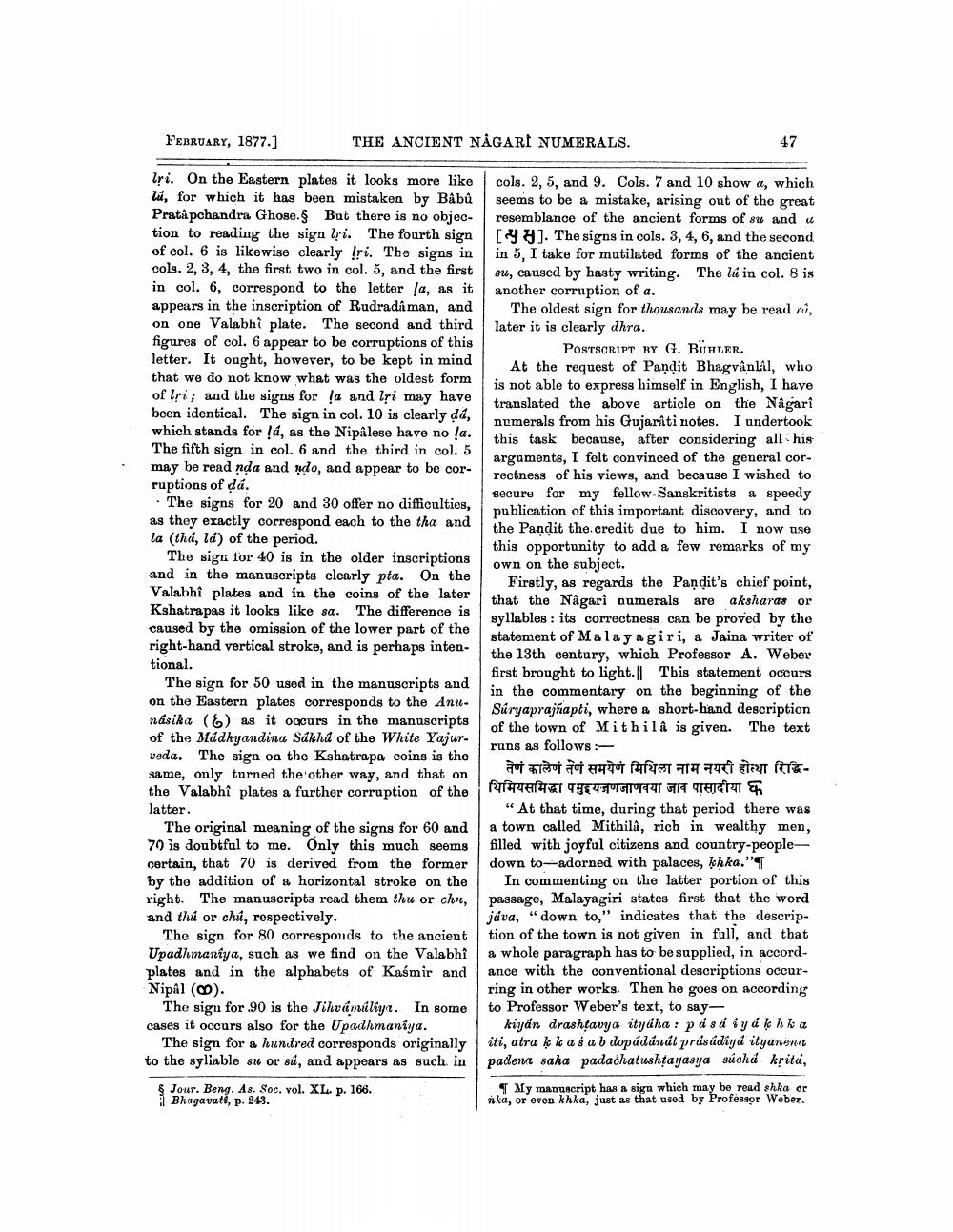________________
L'EBRUARY, 1877.]
THE ANCIENT NÅGARI NUMERALS.
47
lri. On the Eastern plates it looks more like lú, for which it has been mistaken by Bâbû Prata pohandra Ghose. But there is no objection to reading the sign lời. The fourth sign of col. 6 is likewise clearly Iri. The signs in cols. 2, 3, 4, the first two in col. 5, and the first in col. 6, correspond to the letter !a, as it appears in the inscription of Rudrada man, and on one Valabhi plate. The second and third figures of col. 6 appear to be corruptions of this letter. It ought, however, to be kept in mind that we do not know what was the oldest form of Iri; and the signs for !a and lți may have been identical. The sign in col. 10 is clearly dá, which stands for !á, as the Nipalese have no !a. The fifth sign in col. 6 and the third in col. 5 may be read nda and ndo, and appear to be corruptions of dá.
• The signs for 20 and 30 offer no difficulties, as they exactly correspond each to the tha and la (tha, id) of the period.
The sign for 40 is in the older inscriptions and in the manuscripts clearly pta. On the Valabhỉ plates and in the coins of the later Kshatrapas it looks like sa. The difference is caused by the omission of the lower part of the right-hand vertical stroke, and is perhaps intentional.
The sign for 50 used in the manuscripts and on the Eastern plates corresponds to the Anunásika ( as it occurs in the manuscripts of the Madhyandinu Súkhd of the White Yajur. veda. The sign on the Kshatrapa coins is the same, only turned the other way, and that on the Valabhî plates a further corruption of the latter.
The original meaning of the signs for 60 and 70 is doubtful to me. Only this much seems certain, that 70 is derived from the former by the addition of a horizontal stroke on the right. The manuscripts read them thu or chr, and thi or chui, respectively.
The sign for 80 corresponds to the ancient Upadhmaniya, such as we find on the Valabhi plates and in the alphabets of Kaśmir and Nipal (0).
The sign for.90 is the Jihvámiliyr. In some cases it occurs also for the Upadhmaniya.
The sign for a hundred corresponds originally to the syliable su or sú, and appears as such in
cols. 2, 5, and 9. Cols. 7 and 10 show a, which seems to be a mistake, arising out of the great resemblance of the ancient forms of 81 and u [ 4 ]. The signs in cols. 3, 4, 6, and the second in 5, I take for mutilated forms of the ancient su, caused by hasty writing. The lå in col. 8 another corruption of a.
The oldest sign for thousands may be read rů, later it is clearly dhra.
POSTSCRIPT BY G. BÜHLER. At the request of Pandit Bhagvanlal, who is not able to express himself in English, I have translated the above article on the Någari numerals from his Gujarati notes. I undertook this task because, after considering all his arguments, I felt convinced of the general correctness of his views, and because I wished to secure for my fellow-Sanskritists a speedy publication of this important discovery, and to the Pandit the credit due to him. I now use this opportunity to add a few remarks of my own on the subject.
Firstly, as regards the Pandit's chief point, that the Nagari numerals are aksharas or syllables : its correctness can be proved by the statement of Malayagiri, a Jaina writer of the 13th century, which Professor A. Weber first brought to light. This statement occurs in the commentary on the beginning of the Súryaprajñapti, where a short-hand description of the town of Mithila is given. The text runs as follows:
तेणं कालेणं तेणं समयेण मिथिला नाम नयरी होस्था रिद्धिथिमियसमिद्धा पमुइयजणजाणवया जाव पासादीया क
“At that time, during that period there was a town called Mithila, rich in wealthy men, filled with joyful citizens and country-peopledown to-adorned with palaces, khka."
In commenting on the latter portion of this passage, Malayagiri states first that the word java, “down to," indicates that the description of the town is not given in full, and that a whole paragraph has to be supplied, in accordance with the conventional descriptions occurring in other works. Then he goes on according to Professor Weber's text, to say
kiyán drashtavya itydha: pdd fyd kehka iti, atra k k a sab dopádándt prds ddiydityanenn pademt saha padachatushtayasya súchd krita,
Jour. Beng. As. Soc. vol. XL. p. 166. i Bhagavati, p. 243.
My manuscript has a sign which may be read shka or nka, or even khka, just as that used by Professor Weber.




